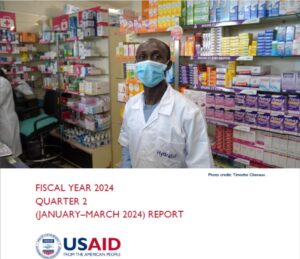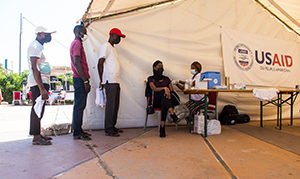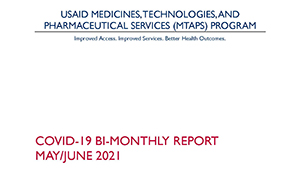MTaPS Support
From 2018 to 2024, MTaPS provided technical assistance to the Government of Senegal (GOS) to strengthen pharmaceutical systems and services to improve antimicrobial resistance (AMR) prevention and containment and preparedness capacity for hemorrhagic fever disease such as Ebola virus disease (EVD) as well as to support Senegal’s COVID-19 emergency response.
Program Objectives
To enhance collaboration and synergy in the fight against AMR, MTaPS’ support followed the One Health approach, which promotes multisectoral coordination (MSC) across the human health, animal health, and environmental sectors.
Support also followed GHSA’s frameworks and guiding principles and WHO’s Benchmarks for IHR Capacities for strengthening AMR containment. Specific activities focused on the country’s adaptation and adoption of WHO tools, including the Infection Prevention and Control Assessment Tool version 2 (IPCAT2), the Infection Prevention and Control Assessment Framework (IPCAF), and the AMS practical toolkit for low-and middle-income countries, as well as the introduction of a continuous quality improvement (CQI) approach to achieve AMR-related objectives.
Building on its GHSA work, MTaPS collaborated with country partners to improve their capacity to respond to the COVID-19 outbreak. Following an EVD outbreak in the neighboring Guinea, MTaPS collaborated with other MOH Health Emergency Operations Center (HEOC) partners and GOS Ministries to develop and implement the national EVD preparedness and response plan.
Key Achievements
Effective multisectoral coordination on AMR
- A national multisectoral AMR Technical Working Group was established with clear terms of reference to coordinate and provide stewardship for AMR activities across human health, animal health, agricultural, and environmental sectors.
- Annual multisectoral AMR action plans developed and implemented by MSC partners were monitored to track progress.
Infection prevention and control
- The national IPC program and practical manuals for health facilities were revised to align with WHO standards ensuring that health care practices follow globally recognized best practices.
- National IPCAT and facility IPCAF assessments were conducted to identify core IPC program improvements and a prioritized action plan developed to strengthen IPC capacity.
- A national IPC supportive supervision checklist for health facilities that consistently evaluates IPC gaps, measures, and improvements was updated and rolled out in all health facilities nationwide.
- More than 1,000 health care workers were trained on revised IPC guidelines to foster improved IPC practices in facilities.
- CQI was implemented at 12 MTaPS-supported health facilities to provide a way to identify and address IPC challenges through continuous monitoring using the WHO IPCAF tool and to make sustainable improvements.
- Of 13 facilities supported by MTaPS:
-Infection control committees were revitalized and made functional.
-All showed improvement per the IPCAF assessment, demonstrating their increased, sustained commitment to safer health care.
-10 improved adherence to hand hygiene and IPC guidelines, an important step toward reducing HCAI prevalence.
Use of antimicrobial medicines optimized
- Rapid situational analysis of the regulations, control, and use of antimicrobials was conducted to guide the creation of a national AMS plan to improve antimicrobial use across multiple sectors.
- The national antibiotics treatment guidelines were updated in collaboration with the National Committee for Antibiotic Treatment to integrate the WHO Access, Watch, and Reserve (AWaRe) categorization of antibiotics to standardize treatment practices; revised guidelines were distributed to 14 hospitals and used to train 110 prescribers.
- CQI was implemented in 3 health facilities to improve AMS practices and 19 trainers were trained on AMS to provide ongoing education on antibiotic use and improve antibiotic prescription practices.
COVID-19 and Ebola virus disease
- The capacity of the MOH National Department of Hygiene was strengthened to be able to conduct decontamination and disinfection sessions to reduce the spread of disease at health facilities, homes, and morgues, including 859 sites in Dakar, 99 sites in Thiès, and 27 in Diourbel.
- The capacity of the MOH HEOC was strengthened, allowing it to implement IPC for COVID-19 containment in 48 treatment centers in the 3 most affected regions—Dakar, Thiès, and Diourbel—and in 8 health facilities in 4 additional regions.
- 13 COVID-19 vaccination microplans were created at regional and district levels, which proved to be an efficient tool to help increase vaccine coverage; as a result, the MOH’s Expanded Vaccination Program rolled out microplanning nationwide for all vaccines.
- SOPs were developed on psychosocial care of patients, families, and health care workers affected by EVD; 2,000 hard copies of the SOP manual for the control and management of Crimean-Congo viral hemorrhagic fever were given to GOS EVD incident manager.
- A needs assessment was conducted at 18 land border entry points to provide EVD incident manager and other stakeholders with information on operating temporary care sites in accordance with EVD and hemorrhagic fever disease SOPs.




